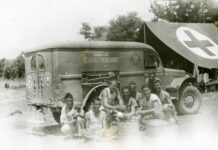Wars define eras. They are events that take place on such a huge scale that millions are involved. Nations are broken. Maps are changed. Many stories come out of wars. They are the stories that show a nation’s character, show the character of its people and show the character of its soldiers.
World War II
During World War II, you couldn’t find women in the trenches, you couldn’t find them on attack boats, but you could see them in the sky. Women Airforce Service Pilots (WASPs) flew all manner of U.S aircraft, delivering and repositioning them to bases across the country as needed and freeing up male pilots for combat overseas.
Those planes were held together by the work of Mazie native Ruby Taylor and her colleagues. Her job was just as tough as flying a plane. As an airplane mechanic at Tinker Field (there was no “Air Force” then), she repaired planes. Only a teenager, she worked there through the war.
“The whole group was women. The only ones that weren’t women were supervisors, but most of the work was done by women,” says Taylor. “And every one of the ladies worked in all temperatures.”
Taylor and 20 million other women that filled in jobs for the men shipped overseas gave birth to the cultural icon, Rosie the Riveter.
Vietnam
On Aug. 7, 1964, President Lyndon B. Johnson declared war on Vietnam, a small Asian country of which most Americans had never heard. By 1969, the draft was on and hundreds of thousands of young men were sent overseas to fight communists in the sweaty jungles and muddy rice paddies of Vietnam.
At home, the Age of Aquarius was in full swing. San Francisco’s Haight-Ashbury had been transformed into the hippie capital of the United States. Woodstock was more popular than anybody could have expected. These were the images Americans saw on TV during dinner. But they were often sandwiched between shots of body bags and a young Dan Rather fumbling for the words to describe the atrocities of war.
By this time, the potential for women’s service in the military was recognized by all four of its branches. More than 10,000 women – not including those that served in the States – served in Vietnam. Just like their male counterparts, they won Purple Hearts and Bronze Stars.
Before the Vietnam War was acknowledged as a failure, Oklahoman Carol Mannahan served as a nurse at central California’s coastal Fort Ord. A member of the U.S. Army Nurse Corps, Mannahan tended to the thousands of wounded American soldiers sent home for medical treatment that they couldn’t receive in Vietnam.
Mannahan signed on at a time when being shipped out to Vietnam was a real possibility.
“I was in Iowa at nursing school at the time. Some recruiters came to our school. The Vietnam War was going on, and I felt like I should do something meaningful in that war,” she says.
“When these recruiters came, I thought, ‘I could be a nurse and help these soldiers.’ It was pretty exciting to have those recruiters come and speak to our class about the role of nurses in the military. I was ready for a challenge, too. I was young but wanted to travel. This was the opportunity.”
The Vietnam War did for Mannahan’s family what it did for so many others – split it right down the middle. While politicians civilly debated the value of the war on television and in newspapers, heated arguments raged in many American households. It was fully unlike World War II, when, once the nation committed to war in Europe, everybody saw the necessity of helping out with the war effort. There were no rubber or scrap metal drives during the Vietnam War.
“The Vietnam War was not popular,” she says. “I wasn’t a politically involved young woman at the time, so that didn’t matter to me. The husband of my roommate in nursing school was killed over there, and that had a big impact on me. I saw a big need there for nursing care. I wasn’t at all aware of the political climate. After I enlisted, my family got a lot of pushback about it. A family member said some hurtful things to my father about it. My dad was really proud of me for doing this, while this family member said some really derogatory things about me for doing it. That led to a huge confrontation.”
The fighting continued overseas while the squabbling continued stateside. The soundtrack for both included bands and performers that would change music forever. Mannahan’s favorites were The Beatles, Iron Butterfly, Simon and Garfunkel and Santana.
At Fort Ord, Mannahan specialized in orthopedics. She never stood on the battlefield, but she did a lot of moving around the wounded. She saw more than her fair share of the casualties of war.
A First Lieutenant, Mannahan took the night shift at the base hospital. She supervised five orthopedic wards, each one having 30 to 40 patients at any given time.
Each and every day put her in close contact with soldiers – men – who were used to female nurses, but who weren’t used to female officers. But getting and keeping their respect was never an issue.
“They were unbelievably respectful of me. One of the young men trained everybody in the unit to sit at attention while I walked down the ward. He felt that, as a lieutenant, I should have respect. Every time I walked down the ward, if they could stand they would, and they sat up if they couldn’t. But he felt it was important for the men to show that respect,” recalls Mannahan.
The women’s liberation movement gathered a lot of steam after the Vietnam War. With 20,000 female boots on the ground in Vietnam, it’s not surprising. You didn’t have to be a soldier to see women doing traditionally male military jobs. That realization led directly to arguments about fairness in the workplace and equal pay. It also gave birth to a small argument about the ability of women to serve on the front line. It’s an argument that’s been in play since the mid 1970s and continues today.
Operation Desert Shield
Twenty-five years after Mannahan returned to college, Oklahoman Angela Hall joined the Navy. Serving from 1995 to 2000, Hall, Petty Officer 3rd Class, just missed Operation Desert Shield. But she saw her fair share of action in the Gulf War as a civilian contractor with Haliburton shortly after she left the military.
“I had to get out of the military to go to a war zone,” she jokes.
Before she joined, America had taken its place as the only global superpower. The Cold War was over and all of Ted Turner’s employees had bits and pieces of the Berlin Wall encased in plastic paperweights on their desks. There were, of course, hot spots around the world, but “Pax Americana‚” appeared achieved. Then President George Bush sent American troops to defend Kuwait and later to push the Iraqi army back to Baghdad.
U.S. forces destroyed the opposition, and Operation Desert Shield showed the rest of the world that America would go to war to protect its allies and preserve the peace. It also showed the U.S. military’s willingness to put women in combat roles, particularly as artillerymen. U.S. soldiers – men and women alike – were recognized the world over as nothing short of the best of the best.
Even in peacetime, the Navy kept Hall busy. She served as a hospital corpsman, somewhere between a nurse and a paramedic, she says.
“You basically rotate jobs. I did everything from working the ambulances on the base to doing screenings for sick call to medical records and training people that were getting ready to transfer overseas,” she says.
Evolving Roles
The military’s come a long way since Rosie the Riveter. It’s 2011, and the armed forces are committing women to the same dangerous jobs as men (except for serving in the infantry). But for those thinking that the Tailhook Scandal is par for the course in the Navy, Hall disagrees.
“I think where we would have run into negative attitudes would have been on the ships themselves,” she says. “But I didn’t have any problems with the male sailors I worked with.”
Like many in the service, Hall wrestles with the question of whether women should be on the front lines of military conflicts.
“I think there are women that can do the job. However, I think men are naturally inclined to protect women and I think that if they see a woman injured, they’d react differently than if it were a man. They’d lose their train of thought if they saw a wounded woman instead of a wounded man. And that’ll put everyone in danger,” she says.
But she doesn’t waver in her belief that women are capable of serving on the front lines.
“Physically, if they’re able to pass the tests, then women should go for it. But the standards shouldn’t be lowered in order for a women to fill those spots,” she says.
Eventually, the U.S. will allow women to serve as infantrymen – without lowering standards. The Congressional Military Leadership Commission, established in 2009, is already leaning on the Pentagon to do so, but they do not have to lean too hard. President Barack Obama’s Pentagon is signaling legislators that it’s ready to make the change. And a very small number of women are about to be placed on the front lines in Afghanistan.
From Rosie the Riveter to nursing the wounded to seeing the whites of the enemy’s eyes, women have long been essential to American war efforts.





















